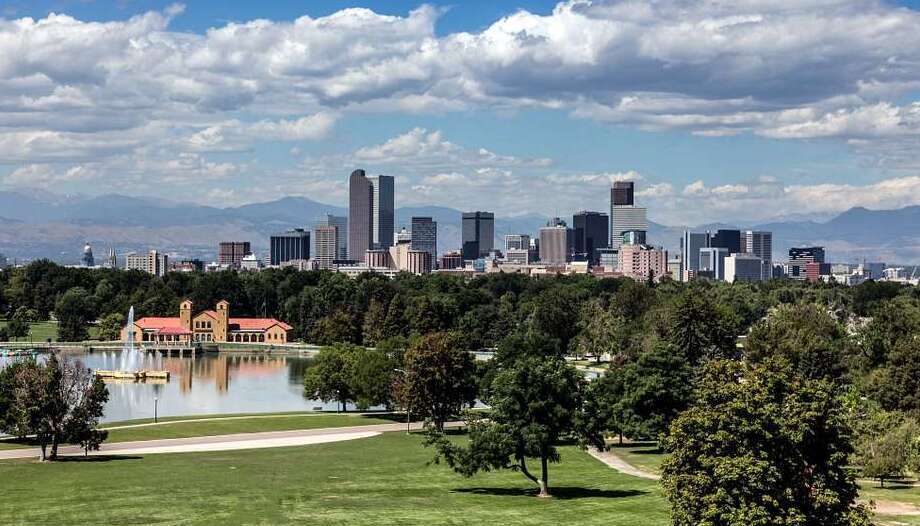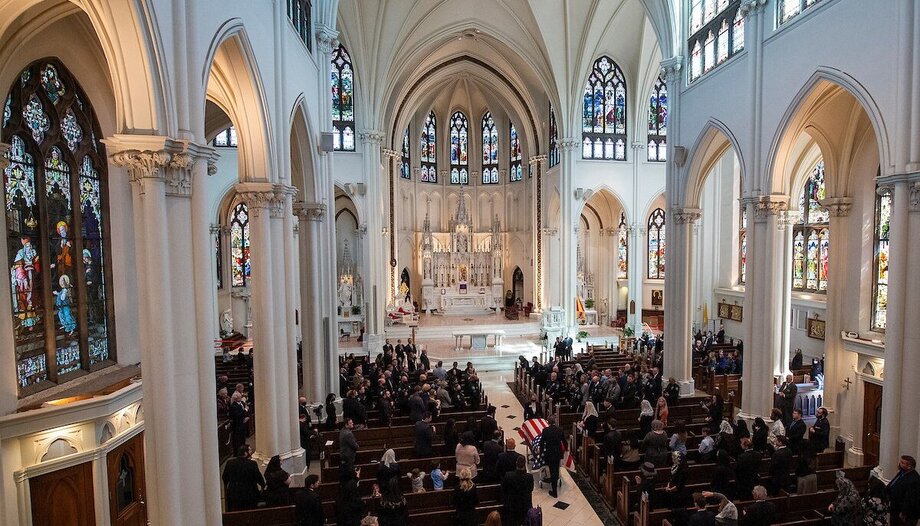Denver is the state capital of Colorado. It is located at the base of the Colorado Rocky Mountains, east of the foothills of the Front Range. Because of its altitude at 1,609 meters above sea level, it is known as the "Mile-High City". Although Denver is not above the mountains, they dominate the view of the city.
Denver is known not only for its natural beauty (which attracts thousands of tourists) but for its cultural life, thriving economy and, from a faith perspective, for the impact it has had on the church nationwide. Denver has been the seedbed of many apostolates and lay movements that have had an impact on church life in the country. Some of these were born after World Youth Day and the visit of Pope John Paul II in August 1993.
The state of Colorado and the city of Denver
Colorado is the eighth largest state in the United States. It is located in the western region of the country, in the mountainous areas, bordered to the north by the state of Wyoming, to the south by New Mexico, to the east by Kansas, to the west by Utah and to the northeast by Nebraska. Three of the country's major rivers originate in the state: the Colorado River, the Arkansas River and the Rio Grande. It was named after the Colorado River, a name given by Spanish settlers. The Rocky Mountains cross the state and extend from northern British Columbia (Canada) to southern New Mexico.
Colorado was part of three nations: the eastern part belonged to France. This was acquired by the Americans with the purchase of French Louisiana in 1803. The western part was part of the Viceroyalty of New Spain until Mexico gained independence from Spain in 1821. The western part of Colorado was Mexican territory until the U.S.-Mexican War 1846-1848, after which Mexico lost ("ceded" as U.S. historiography calls it) more than half of its territory.
Colorado was incorporated into the U.S. territory in 1861 and was admitted as a state in 1876, which is why it is called the "centennial state" because it occurred on the 100th anniversary of American independence. The city of Denver was incorporated in November 1861. Four years later it would become the territorial capital and in 1876 the capital of the new state of Colorado.

The settlers
The eastern part of the Rockies was a migratory route for Native peoples and explorers. Historically, the Colorado region was inhabited by various Native American groups, including the Pueblo, Apache, and Comanche. The first European settlers arrived in the 17th century, but it was not until 1787 when Juan Bautista de Anza established the San Carlos settlement near the Pueblo town.
Other permanent settlements followed in northern Colorado after the discovery of gold in the area in 1858. To service the nascent mining region, railroads were built and services were established to serve the needs of the community. The city of Denver was founded in 1858 as a mining town. It was named "Denver" in honor of Kansas Territory Governor James Denver.
The Church in Colorado and Denver
The presence of the Church in the region dates back to the 18th century with the Franciscan friars who established missions in southern and western Colorado. During its time as a Mexican territory, Mexican clergy were in charge of the area. It was until 1851 when the missions were attended by priests from New Mexico. In that decade, settlements with permanent communities were established in San Pedro (1852), San Acacio (1853) and Conejos (1854).
Ecclesiastically the area belonged since 1850 to the Apostolic Vicariate of New Mexico, which would become 3 years later the Diocese of Santa Fe, led by Bishop John Lamy, who in 1857 established the parish of Our Lady of Guadalupe in Conejos, Colorado. John Lamy was succeeded by John B. Salpointe, who was key for Colorado to separate from the Diocese of Santa Fe and form a new ecclesiastical jurisdiction, forming first the Apostolic Vicariate of Colorado and Utah in 1868 and finally in 1871 the Apostolic Vicariate of Colorado, which encompassed the entire state.
Its first bishop was Joseph Machebeuf (1868-1889), who had already served as a missionary in the area for 20 years. Upon taking office, Machebeuf toured Europe in search of priests and a financial loan. He returned from his trip with five priests, only one English-speaking, who was assigned to a parish in Denver. The others were sent to Hispanic parishes in the St. Louis and Arkansas valleys of southern Colorado. By 1870 the state's churches could accommodate 8,500 parishioners in 14 parishes. The number of Catholics outnumbered the Protestant population.
In 1860 the region grew demographically due to the migration of thousands of Catholics from neighboring New Mexico. By 1890, half of Colorado's Christians (47,000) were Catholic. To assist in the mission, in 1871, the first Jesuits arrived and took charge of the parishes in southern Colorado. The construction of the first three Catholic schools also began during this period. The first was St. Mary's Female Academy in 1863.
The vicariate apostolic became the Diocese of Denver in 1887, with Machebeuf as its first bishop and Nicholas Chrysostom Matz as coadjutor. Upon taking office Matz was charged with conducting the first synod of the diocese in 1890 as well as building the Cathedral of Our Lady of the Immaculate Conception and establishing St. Thomas Seminary. Bishop John Henry Tihen succeeded Matz in 1917. Tihen focused on education, especially the expansion of the Seminary.
During this period three hospitals, an orphanage and an old people's home were built. In 1921 the cathedral was consecrated. In 1931 Bishop Urban J. Vehr succeeded Tihen. Bishop Vehr led the diocese for 36 years, the first 10 years as bishop and then archbishop when Denver became an Archdiocese in 1941 and at the same time the new diocese of "Pueblo", Colorado was formed, separating a part of the territory. The Catholic population of Colorado in that year was 147,000. Archbishop Vehr was succeeded in 1967 by James V. Casey (1967-1986) who headed the jurisdiction during the years of the Second Vatican Council. Casey created new offices to coordinate parish programs and ministries, especially those dedicated to the family, social services and the Hispanic population.
WYD in Denver
In 1986 James Francis Stafford became the sixth bishop of Denver. During his tenure, World Youth Day (WYD) was held in 1993, attended by Pope John Paul II and thousands of young people. This event was a turning point in the church in the United States, not only because it was a seedbed for priestly and religious vocations, but also because it was the seed of many lay apostolates that were born in Denver.
During the homily At the concluding Mass of WYD on August 15, 1993, John Paul II told young people: "Do not be afraid to go out into the streets and public places, like the first Apostles who preached Christ and the good news of salvation in the squares of cities, towns and villages. It is not a time to be ashamed of the Gospel. It is time to preach it from the rooftops. Do not be afraid to break away from comfortable and routine lifestyles, to accept the challenge of making Christ known in the modern metropolis. Go to the crossroads and invite everyone you meet to the banquet that God has prepared for his people. Do not hide the Gospel out of fear or indifference".
On the 30th anniversary of that visit, Archbishop Aquila said, "You can recognize the tremendous fruit that WYD '93 bore in the Archdiocese of Denver. It had an impact on the vocations we have and the establishment of the Redemptoris Mater (Neocatechumenal Way) and St. John Vianney seminaries, as well as the various apostolates that came out of them. Before WYD 93 both seminaries did not exist, the "Augustine Institute" did not exist, "FOCUS" (campus ministry) did not exist".
In 1996 Stafford was appointed President of the Pontifical Council for the Laity and in 1998 he was created a cardinal. He was succeeded as Archbishop of Denver by Charles J. Chaput (1997-2011). A member of the Native American "Potawatomi" tribe, Chaput became the second Native bishop to lead a diocese. During his administration, John Paul II appointed Jose H. Gomez as auxiliary bishop of Denver. Together with Chaput, he founded the St. Juan Diego Center in Denver in 2002 to respond to the pastoral and educational needs of the Hispanic community. Chaput and Gomez later founded the Catholic Association of Hispanic Leaders, CALL (Home | CALL USA (call-usa.org)). Bishop Chaput was also providential in the creation of "ENDOW". Educating on the Nature and Dignity of Women (endowgroups.org)a Catholic women's leadership initiative to "educate about the nature and dignity of women".
The Archdiocese of Denver
The Archdiocese of Denver is located in the northern part of the state of Colorado. The territory currently covers 25 counties. It was erected as a diocese in 1887 and in November 1941 it was promoted to Archdiocese. In May 2012, Pope Francis appointed Samuel Joseph Aquila as the eighth bishop of Denver. In 2016, the pontiff assigned Bishop Jorge Rodriguez as auxiliary of the jurisdiction.
The archdiocese has approximately 600,000 Catholics, as well as 148 parishes and missions. There are 313 priests, 195 deacons and 173 religious. The mission of the archdiocese states: "The Archdiocese of Denver exists so that in Jesus Christ all may be saved and have abundant life, to the glory of the Father". In this regard, Archbishop Aquila, noted in July 2024: "In the Archdiocese of Denver we have a mission value that I preach and speak about very often. We call it 'Remain in relationship.' It's simply the value by which we remain and grow in charity, in intimacy with the Father, Son and Holy Spirit. When we remain in that primordial relationship we are moved to embrace the mission of the Redeemer. Pope St. John Paul II wrote: 'The universal vocation to holiness is closely linked to the universal vocation to mission. Every member of the faithful is called to holiness and to mission' (Redemptoris Missio, 90)".
The archdiocese has two Catholic newspapers: "El Pueblo Católico" and "Denver Catholic". In Denver there are 4 Catholic hospitals, 35 elementary and middle schools and 9 high schools. These institutions employ 1,100 teachers dedicated to the education of 12,000 children per year. For low-income students, the church awards scholarships to 1,000 students annually in the amount of 2 million dollars.
Social and charitable services
In the archdiocese there are several lay ministries that provide social services, among them the "Society of St. Vincent de Paul" which helps 21,000 people a year with financial support for rent, food, clothing and medicine. Likewise, the apostolate called "Christ in the City"(Christ in the City) provides an important service to the homeless and destitute. Likewise, the Catholic prison ministry supports 800 people a week in 40 locations.
Catholic Charities in Denver helps more than 113,000 people. Its shelters provide 500,000 meals a year and provide emergency assistance of about $6.3 million. Parishes, missions and various Catholic charities operate food banks, soup kitchens, and food and clothing donations. They also offer mental health services and organize support groups for people with addictions.







